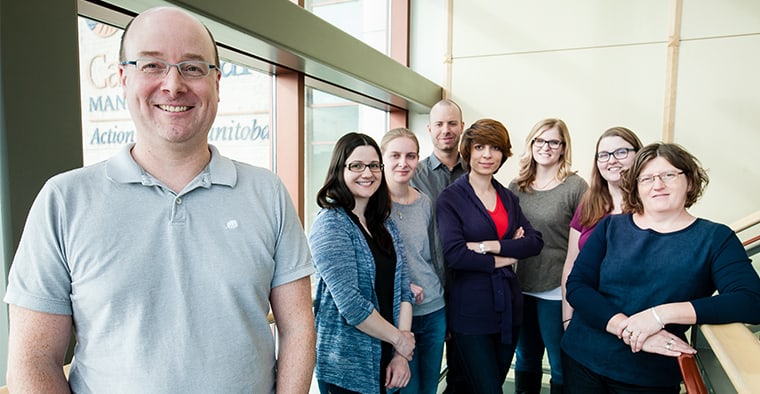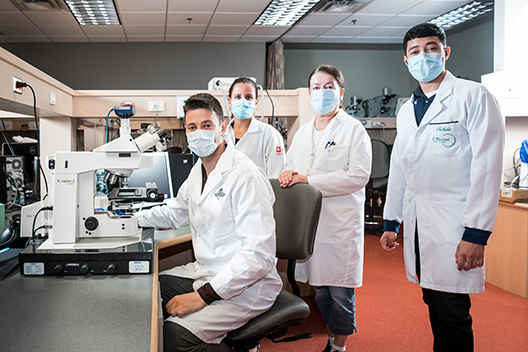Five years ago we introduced you to Dr. Versha Banerji, who had just returned home to Winnipeg after four years of research and training at Harvard along with her husband Dr. Shantanu Banerji. The couple, who met in medical school and married, specialized in hematology and medical oncology specialties respectively. Their time at Harvard was sponsored by CancerCare Manitoba and fully supported by donors.
Their plan post-Harvard – return to help build Manitoba’s cancer research program while providing clinical care to patients.
Harvard training promises discoveries in Chronic Lymphocytic Leukemia (CLL) research
Dr. Banerji’s research in Acute Myeloid Leukemia held a lot of promise as upon her return she could transfer her discoveries to Chronic Lymphocytic Leukemia (CLL), where CancerCare Manitoba is an acknowledged leader in the field. She was recently granted the Research Manitoba New Investigator Award for her research study Resetting the Clock: Modifying Circadian Rhythm in CLL.
Dr. Banerji, a clinician scientist at CancerCare Manitoba, and senior scientist at CancerCare Manitoba’s Research Institute competed against scientists from around the province, every university and research program, and is thrilled she was able to receive this prominent award.
“Typically these awards go to scientists with one hundred per cent protected time for research. It’s harder for clinicians with dual responsibilities as a clinician scientist to prove that they’re equally worthy,” she says.
As a doctor balancing her work in the clinic with her research, she would need some way to compete with scientists who could devote all of their resources to research. That’s where the generosity of the Foundation’s donors came in, because without you, none of this would have been possible.
“Thanks to the Foundation’s donors, I had a generous start-up that allowed me to get my feet wet, buy new equipment, hire staff, and recruit a post-doc fellow,”says Dr. Banerji. “This allowed me to generate data so I could actually apply to other granting agencies to secure other funds.”
Your contributions have been essential to this amazing work, as your trust in Dr. Banerji’s research meant she could focus on CLL and the fight against cancer, instead of worrying about finances. And now with this new award, that steady focus can continue as she will receive $75,000 for each of the next three years.
“I think this award shows how committed the Foundation’s donors are to my success,” she says. “And it demonstrates that CancerCare Manitoba can protect its clinician scientists, so that they can be equally successful in the future. It’s good for all parties involved.”Connecting the dots on the shift-work effect
Dr. Banerji’s groundbreaking research is in the connection between the circadian rhythm and CLL. The circadian rhythm is essentially your body‘s clock; it is the physical, mental and behavioral changes in your body that follow a roughly 24-hour cycle and respond to light during the day/night cycle. Your circadian rhythm can be changed by travelling through different time zones on an airplane, rotating between night shifts and day shifts, mental health problems, and many other factors. She’s examining these physiological variables and seeing the affect it has on cancer cells.

“I’ve been very aware of the epidemiological studies that say people who do shift-work are more likely to get cancer,” she says. “It includes people with metabolic disorders, diabetes, or who just have disrupted circadian rhythms.”
Since it’s shown that an agitated circadian rhythm can have negative health effects, particularly when it comes to cancer, this leaves Dr. Banerji ready to search for answers.
With this new grant, a lot of those answers will come from her experiments with light and dark chambers, using different treatments and seeing their effects. She’ll be able to look at the problem in two ways. One will be taking those already affected by a disrupted circadian rhythm, then altering it and targeting that to help kill cancer cells. The other is modulating the circadian rhythm to prevent cancer from even happening in the first place.
But it won’t be so simple and straightforward. “With genes, it’s complex. There are genes that control other genes which regulate circadian rhythm, but those genes also regulate tissues in all the different parts of your body so that they don’t grow at the wrong time,” she says.
This means she won’t just be going into the lab and altering cells haphazardly. Instead, she will be carefully looking at these cancer cells and checking for gene abnormalities, and looking for ways to normalize them and prevent the cancer from growing further. If she’s able to make a link like that, then perhaps she can prevent cancer from growing at all. What makes this type of research even more special is that it simply hasn’t been done by anyone yet.
The Five W’s
“There are large clinical epidemiological studies which have correlated that cancer and shift-work are linked but there is no direct study in each cancer type. No one has said ‘this is a CLL cell, this is the gene expression pattern at baseline, and how it has changed to become more aggressive is related to changes in circadian rhythm.’ Maybe if we treat them with different drugs or even low doses of drugs, we can modulate the circadian cycle. No one has done that before.”

One great thing Dr. Banerji points out about this research is that is that it ultimately promotes healthy living in ways that aren’t as obvious.
“It gives more credence to the exercise physiology and health prevention modes, because we can actually link that circadian regulation, hopefully, in the future,” she says. “Everyone says exercise is good for you, but maybe this is why.”
And her eye on the future doesn’t stop there. The ambitious doctor already knows what she needs to do next.
“I’ve tapped into all the local funding that I can, and now I’m trying to gain traction so that I can get some national funding too.”
The remarkable progress of Dr. Banerji’s research has been made possible by your generous support of the Foundation. What she knows today compared to five years ago is like “night and day.”






